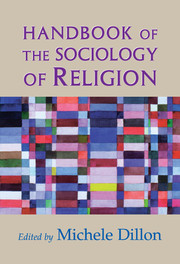Book contents
- Frontmatter
- Contents
- List of Contributors
- Acknowledgment
- Part One Religion as a Field of Sociological Knowledge
- Part Two Religion and Social Change
- Part Three Religion and the Life Course
- Part Four Religion and Social Identity
- Part Five Religion, Political Behavior, and Public Culture
- 21 Religion and Political Behavior
- 22 Religious Social Movements in the Public Sphere
- 23 Mapping the Moral Order
- 24 Civil Society and Civil Religion as Mutually Dependent
- 25 Religion and Violence
- Part Six Religion and Socioeconomic Inequality
- References
- Index
21 - Religion and Political Behavior
Published online by Cambridge University Press: 05 June 2012
- Frontmatter
- Contents
- List of Contributors
- Acknowledgment
- Part One Religion as a Field of Sociological Knowledge
- Part Two Religion and Social Change
- Part Three Religion and the Life Course
- Part Four Religion and Social Identity
- Part Five Religion, Political Behavior, and Public Culture
- 21 Religion and Political Behavior
- 22 Religious Social Movements in the Public Sphere
- 23 Mapping the Moral Order
- 24 Civil Society and Civil Religion as Mutually Dependent
- 25 Religion and Violence
- Part Six Religion and Socioeconomic Inequality
- References
- Index
Summary
In the history of social science research on group-based political alignments, religious cleavages have often been shown to be a more powerful predictor of individual voting behavior than class location (e.g., Rose and Urwin 1969; Converse 1974; Lijphart 1979; Dogan 1995; Brooks and Manza 1997). Yet it has received significantly less attention than studies analyzing class politics, and even when acknowledging the existence of religious-based political divides, scholars have often assumed that some other, nonreligious antecedent factor lays behind it. As Demerath and Williams (1990: 434) put it, “While students of voting do cite religious affiliation as a significant variable, they often tend to interpret its effects less in terms of theology and ecclesiastical influence than in terms of ethnic, class, and regional factors lurking beneath the symbolic surface.”
Since the late 1970s, however, dramatic religious mobilizations around the world – including a fundamentalist Islamic revolution in Iran, the visibly active role of the Catholic Church in the Solidarity movement in Poland in 1980–1, growing publicity about “liberation theology” movements in Latin America, and, in the United States the rise of politically active conservative Christian organizations such as the Moral Majority – have made it more difficult for scholars to ignore the ways in which religion shapes political action and behavior. And indeed, over the past fifteen years there has been considerable growth in research on (and scholarly controversies about) the association between religious group memberships, doctrinal beliefs and practices, and voting behavior.
- Type
- Chapter
- Information
- Handbook of the Sociology of Religion , pp. 297 - 314Publisher: Cambridge University PressPrint publication year: 2003
- 18
- Cited by



